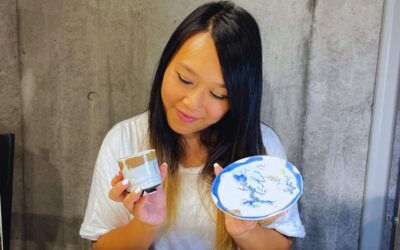Are you planning a trip to Japan during the peak Cherry Blossom season in March and April and want to ensure you make the most of your time?
Look no further! This 1-week Japan itinerary featuring sakura is tailor-made to immerse you in Japan’s iconic Sakura season. Packed with must-see experiences and cherry blossom viewing opportunities, it promises an unforgettable journey. Get ready to create some beautiful and oh-so-pink memories in Japan!
Just a heads up, this itinerary offers plenty of flexibility. Depending on your preferred pace, feel free to tweak the destinations to suit your Japan bucket list.
Day 1: Tokyo
Skytree 東京スカイツリー

The Tokyo Sky Tree, which is 634 meters tall, is the city’s tallest tourist attraction. You can easily spend an entire day at this tower, whether that means gazing across the Tokyo skyline from the observation deck or shopping in the adjacent Tokyo Solamachi shopping center is up to you. Inside Solamachi, you can find many spring-themed traditional Japanese treats, such as strawberry daifuku or pink Lassi drinks. There’s also an aquarium and planetarium at the base of the structure.
Each of the four elevators Podium-Tembo Deck elevators at Skytree are themed after a different season. The ‘summer’ lift is embellished with Edo facets that show fireworks over the Sumida River. Try and match the elevator for the season in which you visit!
Asakusa 浅草

The oldest temple in Tokyo, Senso-ji Temple, should not be missed when seeing the city. The temple, which is well-liked by international visitors, is jam-packed with people attempting to get pictures in front of the huge paper lanterns of the Kaminarimon entrance.
Long-established souvenir and Japanese confectionary stores, as well as sweet shops ideal for eating and strolling, along the Nakamise Street that leads from Kaminarimon. The greatest location to try ningyoyaki (doll-shaped pancakes), an Asakusa specialty. Comparing the flavours of various businesses is one of the finest ways to experience Asakusa.
Sumida River 隅田川

Sumida River is a popular location for cherry blossom viewing that was named one of the top 100 places to see them. According to legend, Tokugawa Ietsuna, the fourth shogun, ordered the planting of the first cherry trees during the Edo period.
Another 100 cherry trees were planted by Tokugawa Yoshimune, the eighth shogun, in 1717, and today there are about 300 cherry trees on the Sumida-ku side and 600 on the opposite bank in Taito-ku. Marvel at the beauty of Tokyo Sky Tree along with the cherry trees that line both banks of the Sumida River for about a kilometre.
Ueno 上野

Ameyokocho is a bustling shopping district that stretches from JR Okachimachi Station to just before Ueno Station. It is a maze of about 400 stores that run along the viaduct’s edge and are guarded. Here, you may get anything at incredibly inexpensive prices, from clothing and sundries to fresh fish and other meals. When sightseeing in Tokyo, make sure to stop here as there is also a broad range of gourmet food.
The Tokyo National Museum is quite well-liked in Ueno! It’s the biggest museum in Japan, and the entrance is only 1000 yen—completely worthwhile! Ukiyo-e, Buddhist sculpture, calligraphy, Ainu folklore, samurai relics, and many other exhibitions are featured there. Also, the museum has a lovely tea house and a garden where you may watch the cherry blossoms bloom.
A temple called Ueno Toshogu is surrounded by cherry blossom trees. It still glows a dazzling gold despite having been constructed in 1627! You may wish to visit the peony garden while you’re there. You will see the lovely flowers in the garden after paying 700 yen! It’s an extremely tranquil experience.
Ueno Park 上野恩賜公園
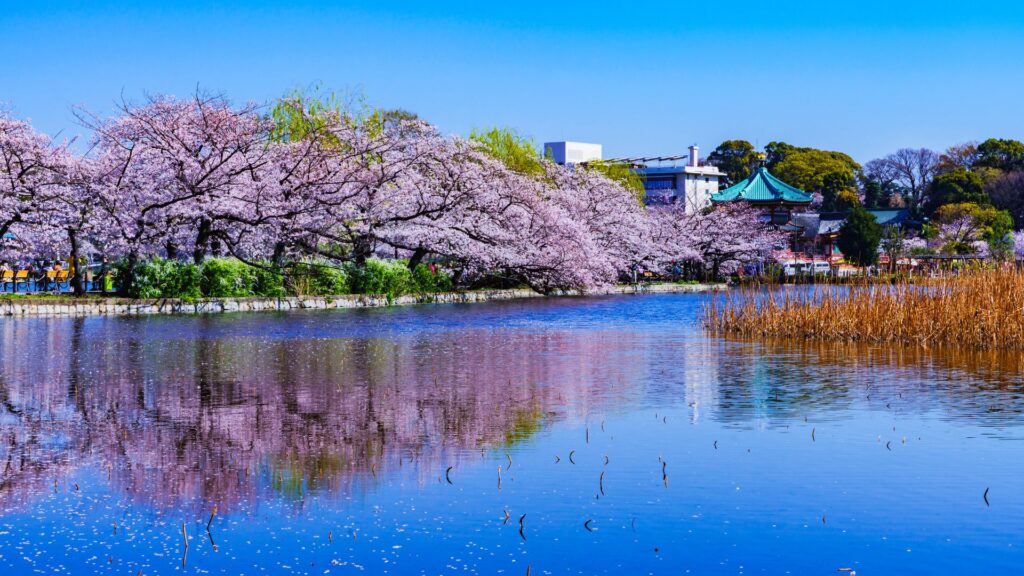
One of the most well-known places to see cherry blossoms in Tokyo is Ueno Park. A well-known location where you may experience nature in the middle of the city is the Shinobazu Pond, which is home to numerous ducks and other waterfowl and blooms with clusters of lotus flowers in the summer.
Since the Edo era (1603–1868), the mountains of Ueno have been renowned for their cherry blossoms, and nature can be fully appreciated all year round. Over 800 cherry trees beautify the park, mostly along Sakura-dori, and are supposed to have been transplanted from Mount Yoshino by priest Tenkai.
There is also the Ueno Zoo in the park, and the cherry blossoms are in full bloom there. It is certainly worthwhile to visit because they have stunning gigantic pandas and enormous turtles!
Meguro River 目黒川

The Meguro River empties into Tokyo Bay through the wards of Setagaya, Meguro, and Shinagawa. Upstream from Nakameguro Station, cherry trees cover the river in an arch from both sides of the riverbank in the Meguro Ward area. These cherry trees, mostly Someiyoshino cherry trees, border the river for about 4 km from close to Ikejiri-Ohashi Station.
During the annual Nakameguro Cherry Blossom Festival and Meguro East Area Cherry Blossom Festival will be held on March 23rd-24th, and on March 30th respectively. During the flowering period, lights and lanterns are lit up from sunset until 8:00 pm.
Meguro 目黒区

There are numerous temples and shrines in Meguro. The Ryusenji Temple is one of them. This temple is actually the inspiration for the name Meguro, therefore you must visit! The serene surroundings of the temple itself have a relaxing impact on everyone. Since the temple is situated inside a park, there won’t be any other structures to get in your way; just peaceful nature!
Day 2: Tokyo
Imperial Palace 皇居

Visits to the Tokyo Imperial Palace are highly recommended. The Imperial Palace is the home of the Japanese Imperial Family. The palace was rebuilt twice, but it still has historical architecture. You may get the most out of your visit by taking one of the free guided tours of the Palace. The gardens are accessible as well. Even those who are extremely stressed out can unwind in these gardens! The public can only access the inner grounds twice a year, on January 2nd and February 23rd.
Chidorigafuchi 千鳥ヶ淵

One of the best spots in Tokyo for cherry blossom viewing, just five minutes on foot from Hanzomon Station and Kudanshita Station. Yasukuni Dori to Kitanomaru Park is connected by a 700-meter promenade that is lined with 260 cherry trees, including Someiyoshino. There are 260 cherry trees along the route, notably Someiyoshino, which blooms every year in late March or early April. Several people stop by the cherry trees’ watery reflection every day, including business folks passing through on their way home from work and couples taking in the cherry blossoms.
Shibuya 渋谷区

You should try to walk the Shibuya Scramble Crossing because Shibuya is noted for its congested streets and lofty buildings. The Scramble Crossing is the busiest road crossing around the world. Even on weekdays, it’s really crowded, but it’s an experience you should have! Try to make your way to Shibuya Sky when you’re close to the crossing. There, you may get a fantastic aerial perspective of the crossing!
You can also see a well-known memorial for movie buffs as soon as you exit the station! You can see Hachi-memorial ko’s here, the dog who waited for his owner. I advise doing this a little early in the day because it gets really busy very quickly. There are lots of adorable shops and entertaining locations in Shibuya.
The Sakura Frappuccino is a great choice for capturing the spirit of the Cherry Blossom season. These are available at Starbucks, which also offers a lovely view of Scramble Crossing. The jelly used is created from actual cherry blossoms, which adds a pleasant touch to the extremely sweet beverage. The Sakura Macarons are the cherry on top, giving it the perfect finishing touch for a cool beverage!
Yoyogi Park 代々木公園

The fifth-largest urban park in all of Tokyo’s 23 wards is divided into a plaza section featuring an athletics track, an outdoor stage, and other amenities and a forest park part that spans the road. It creates a dense forest of greenery when combined with the trees of the nearby Meiji Shrine, and the waterscape amenities, which include three large and three tiny fountains as well as a water corridor, make the area attractive.
There are 600 cherry trees in the park, including Someiyoshino, Oshima, and mountain cherry trees, all of which peak in late March. The Cherry Blossom Garden and the Central Plaza are vibrantly coloured when the cherry trees are in full bloom.
Harajuku 原宿
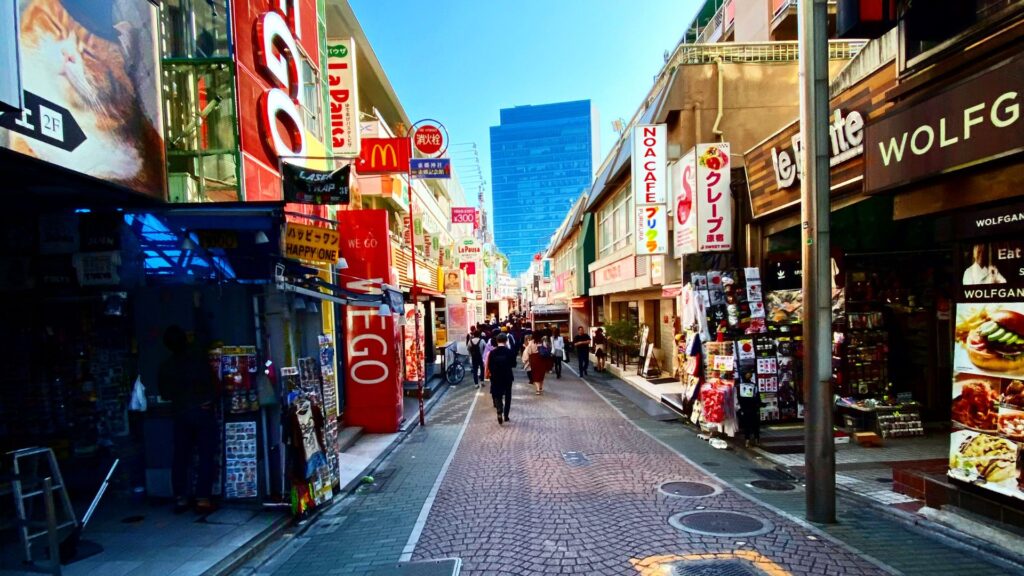
Because Harajuku is recognised as a shopping area, you will undoubtedly discover some adorable clothing here!
Additionally well-known are the numerous animal cafes in Harajuku. There are the typical ones, like cats and dogs, but there are also unique cafes there! I particularly loved the Hedgehog café! You may feed them and hear the tiniest crunch, or you can cradle them and watch them fall asleep in your hands.
Also available in Harajuku are adorable munchies! You can find cotton candy shaped like bunnies or dogs! Or some deliciously tasty crepes with fresh strawberries.
Shinjuku Gyoen 新宿御苑

The garden, which is regarded as a contemporary Western garden representative of the Meiji era, is a deft combination of a formal garden with lovely rows of plane trees, a landscape garden distinguished by wide lawns and lilies, and a traditional Japanese garden. Over 10,000 trees, including lilies, plane trees, Himalayan cedars, and rakusyo, make up the garden’s distinctive scenery. Around 900 cherry trees of roughly 70 types are a major springtime draw. Visit the garden’s official website for more information regarding this year’s hanami events.
Beginning in January, the early flowering cherry trees start to bloom, and by late March, the Someiyoshino cherry trees are at their peak.
Shinjuku 新宿区

Shinjuku area is a terrific location to quickly explore all that Tokyo has to offer. Everything is available in Shinjuku, from bars to neon lights, restaurants to shopping! even in art! Visit the Nishi Shinjuku area and be amazed by the magnificent sculptures that are there.
For those movie buffs out there, the Toho Cinema building’s roof is home to a huge Godzilla head! Simply ascend to the top and savour the sensation—you’ll think you’re part of the show!
Day 3: Kawaguchiko
Kawaguchiko Ropeway 河口湖 富士山パノラマロープウェイ

This Ropeway is almost 400 meters long and it will take you past Mount Fuji! Its panoramic sights are truly one of a kind. A round trip costs 900 yen, which is super cheap compared to the amazing experience you will have.
Niikurayama Sengen Park 新倉山浅間公園

Niikurayama Sengen Park has graced the cover of the Michelin Green Guide Japon. The park is usually even more crowded during the cherry blossom season when many people from all over the world come to photograph the collaboration of Mt Fuji, the five-storey pagoda and the cherry blossoms. A cherry blossom festival is held every year when the cherry blossoms are in bloom.
Fuji-Kawaguchiko Town Cherry blossoms on the north shore of Lake Kawaguchi / Fuji-Kawaguchiko

The most famous cherry blossom spot on Lake Kawaguchi. Fuji, the lake and the cherry blossoms can be seen from here, located to the north of Lake Kawaguchi! There are various facilities nearby, such as the Kawaguchiko Museum of Art and the Orgel Forest Museum, making it a famous sightseeing spot.
Fuji Omuro Sengen Shrine 冨士御室浅間神社

A little-known hole-in-the-wall for tourists. The approach to the historic Fuji Omuro Sengen Shrine is covered with rows of cherry blossom trees and is a sight to behold. Katsuyama Shikkogo Park is also located on the southern shore of Lake Kawaguchi and is recommended for picnics as you can lie on the grass and watch the cherry blossoms.
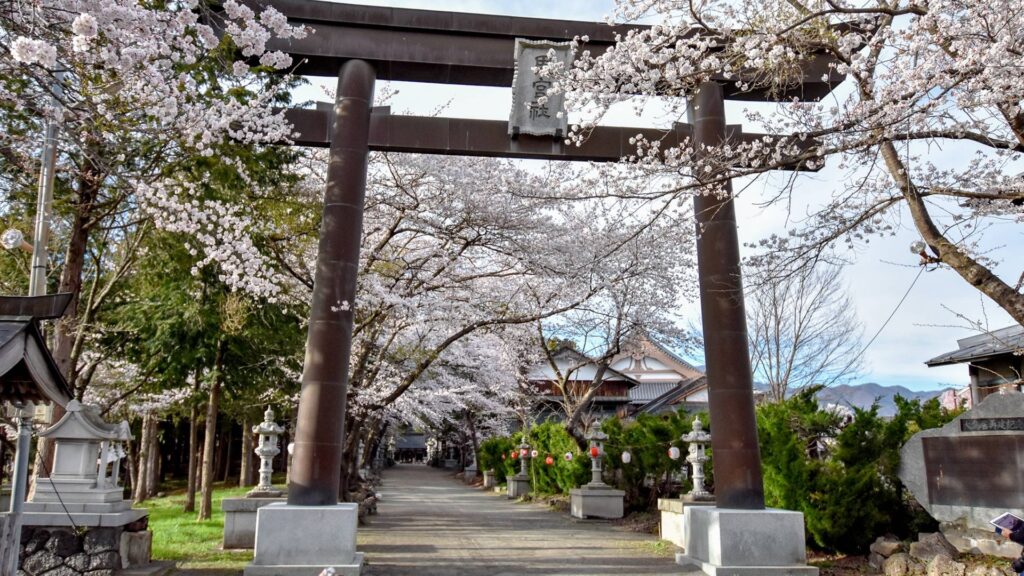
Nearby is Fuji Omuro Sengen Shrine, one of the World Heritage Sites of Mount Fuji, which is a recommended course for sightseeing around Lake Kawaguchi.
Optional: FujiQ 富士急ハイランド

This theme park rests on the base of Mount Fuji. It is primarily known for its record-breaking roller coasters, extravagant rides, and other attractions with an anime theme. The park continuously opens new rides and attractions, including Guinness World Record-breaking roller coasters, in an effort to lead the theme park entertainment industry. Admission to the park is free, but the individual rides cost between 400 and 2000 yen, and a one-day pass for unlimited rides is 6300 yen.
Gotemba 御殿場市

In Gotemba city, you will find the most popular mall in Japan! This mall has around 300 stores and restaurants and even has a hot spring inside! There’s also a 50 metres Ferris Wheel and a whole food court! Guaranteed you can spend the whole day here!
Day 4: Kyoto
Arashiyama Bamboo Forest 嵐山 竹林の小径

The most famous bamboo forest lies in Kyoto! The forest is open 24/7, so you can go explore whenever you want. It’s a lovely place to relax and look at the beautiful bamboo trees. Admission is also free, so it’s a perfect place for budget travellers! The surrounding district also has some fun things that are worth visiting.
Arashiyama, Togetsu Bridge 嵐山・渡月橋

Arashiyama is a scenic spot that has long been a favourite of aristocratic dynasties for its cherry blossoms. The view of Arashiyama over the Watarigetsukyo Bridge, with its rows of cherry blossom trees along the river, is postcard-perfect. The cherry blossoms on Nakanoshima Island are also beautiful, and you can enjoy their blooms to your heart’s content under a clear sky.
Tenryu-ji 天龍寺

The most significant temple in Kyoto’s Arashiyama neighbourhood is Tenryuji. It is now listed as a world heritage site and was formerly considered the best of the city’s five major Zen temples. Among the Japanese Buddhist Rinzai Zen sect, Tenryuji is the principal temple of its own school. Tenryuji’s garden has endured the ages in its original state, unlike the temple buildings. The garden is definitely worth a visit.
Kōdai-ji Temple 高台寺

This temple is another must-visit, especially in spring! Then, they will illuminate the gardens in beautiful colours. They have multiple gardens, including a rock and one with a pond. It is definitely going to help you relax after a long journey!
Known for its maki-e lacquerware, Kodaiji Temple was founded by Kitamasato, the wife of Toyotomi Hideyoshi, to mourn Hideyoshi’s passing. Since the Edo period, the temple has been a popular place for flower viewing. The weeping cherry trees in the Hojo Garden are particularly beautiful, and their drooping branches on the white sand remind one of the serene beauty of Kyoto.
Kiyomizu-dera 清水寺

The “Temple of the Pure Water Spring,” also called Kiyomizu-dera, is a Buddhist temple in Kyoto, Japan. The location is well-known for its spectacular viewing platform, three-story Koyasu pagoda, and the Otowa Spring’s therapeutic, pure waters. Entrance costs only 400 yen, which is very cheap! I highly recommend strolling through the Temple grounds.
The temple is famous for the stage of Kiyomizu. After viewing the cherry blossoms below from the stage, head to the inner sanctuary. From there, you can see the stage surrounded by cherry blossoms. The temple grounds are said to have around 1,000 wild cherry trees and Someiyoshino cherry trees in bloom. You can enjoy the atmosphere as if you are surrounded by a cloud of cherry blossoms.
Gion Shirakawa 祇園白川

This area is amazing to just walk around. There are multiple willows there, as well as cherry blossom trees! The area just feels so zen, that you can’t help but relax. You can also rent a kimono and walk around feeling the Japanese Fantasy!
The elegant Gion area near Tatsumi Bridge. The stone-paved streets are lined with teahouses, decorated with elegant Someiyoshino cherry trees and weeping cherry blossoms. The petals fluttering down the gently flowing Shirakawa River are like snow. This is an elegant spot where you can enjoy cherry blossom viewing while feeling the Kyoto atmosphere.
Maruyama Park 円山公園

When the cherry trees are in full bloom in the first half of April, the park in Kyoto becomes the most well-liked and crowded location for cherry blossom viewing events (hanami). A large shidarezakura (weeping cherry tree), which is illuminated at night, serves as the park’s focal point. It is highly recommended to visit this park to see the cherry blossoms!
The weeping cherry tree, known as the ‘Gion Shidare’, is the most striking feature of the park’s cherry trees in full bloom. The second generation tree was planted some 90 years ago after the 200-plus-year-old tree of the previous generation sadly died. It is famous for its cherry blossoms at night, and the sight of the blossoms floating in the bonfire is a bit enchanting. Bronze statues of Ryoma Sakamoto and Shintaro Nakaoka also stand in the park, as if enjoying the cherry blossom viewing.
Day 5: Kyoto
Fushimi Inari Taisha 伏見稲荷大社
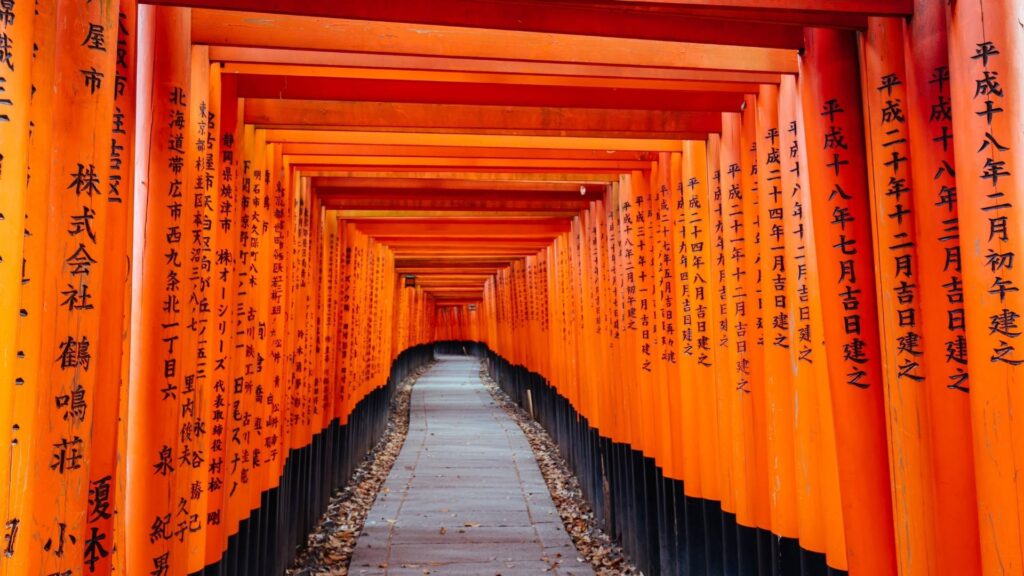
This is probably the first thing you looked up when you were thinking of coming to Kyoto. It is a very popular sightseeing spot! This is because the shrine has a gateway with more than 1000 torii gates. The vibrant red colour makes them a sight to behold. I recommend going early in the morning, to avoid the busy hours.
Kinkaku-ji: The Golden Pavilion 金閣寺
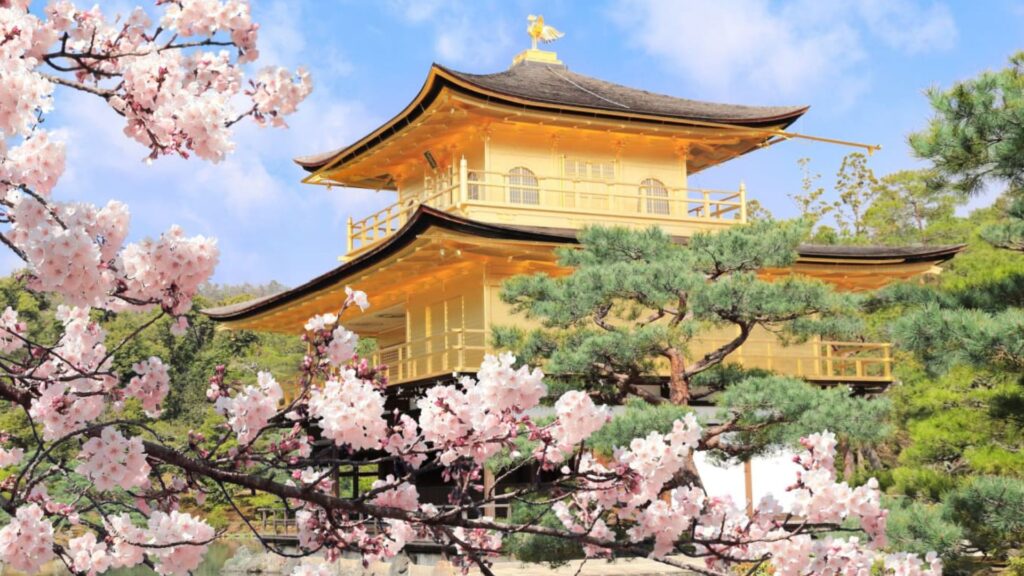
This temple is called the Golden Pavilion, and this is not for nothing. Almost the whole temple is a shining gold. Each floor has its own architectural style, which makes it a bit different from other temples. There is also a beautiful garden, in which you can relax while looking over the pond with many fish inside.
Hirano Jinja 平野神社

The shrine has been a place of worship for more than 1,200 years since the Heian period. It has long been known as a shrine of cherry blossoms, and today, more than 400 cherry trees of about 60 varieties fill the shrine grounds. The Kaikazakura cherry trees are at the top of the list, as well as Butterfly, Ichiyo, Nezame, Goromo, and Kinugasa, which originated with the company. You can enjoy them for a long period of time, depending on the variety. During the night cherry blossom season, a cherry blossom concert, mainly classical music, is held in the hall of worship.
Daihōon-ji Temple 千本釈迦堂

The temple is famous for the story of Okame, a wife who saved her husband’s life. A magnificent weeping cherry tree called Agamezakura blooms in front of the statue of Okame in the precincts of the temple. The tree is graceful, with its branches reaching just above the ground and full of fine, pretty flowers. The calm atmosphere, which seems to reflect Okame’s thoughtful personality, captivates the hearts of visitors.
Ryuhonji Temple 立本寺

The temple was founded by Nichizo Shonin, a grandson and disciple of Nichiren Shonin. A large Someiyoshino cherry tree proudly adorns the temple gate. From there, a magnificent archway of cherry trees surrounds the main hall, making it feel as if you are walking through a cloud of cherry blossoms. There are around 40 cherry trees planted in the grounds, and when they are in full bloom, the hall is filled with cherry blossoms.
Nijo Castle 二条城

Nijo Castle, where the light peach colour of the cherry blossoms adds to the castle’s bloom. Approximately 300 cherry trees of 50 varieties are planted throughout the castle. Many species of cherry trees can be enjoyed, including someiyoshino, yamazakura, shidarezakura and satozakura, and are a sight to behold.
Day 6: Kyoto & Nara
Nishiki Market 錦市場

This street is a food market. It’s also called Kyoto Kitchen because it has more than 100 restaurants lined up in the street! If you’re a foodie, you should definitely visit this street and go to the tastiest restaurants and shops! Almost everything they sell is locally produced and can not be found anywhere else!
Nara Park 奈良公園

Nara Park has gained a lot of popularity lately. It’s a park where wild deer are running free. You can walk around and look at the pretty creatures, maybe they will even come to say hi to you! The park itself is very pretty, it is a great place to hang around!
Todaiji Temple 東大寺

Todaiji Temple is a historical landmark. It has an enormous Buddha in the hall, and the stunning classical Japanese architecture makes it a sight to behold. Here as well, you can find deer roaming around that escaped from the park.
Omizutori お水取り Todai-ji Daibutsuden

The most renowned and impressive event that takes place during Omizutori is Otaimatsu. Every evening from March 1 through 14 just after sunset, enormous torches measuring eight metres in length are carried up to Nigatsudo’s balcony and held over the audience. The blazing embers that fall from the balcony are said to grant anyone watching a year of safety.
Day 6: Osaka
Tsurumi Ryokuchi Park 花博記念公園 鶴見緑地

This park is a 123-hectare tribute to the Netherlands. With the windmill, the blooming tulips and the barbeque space, you can feel like you’re on the other side of the planet! They even have over 100 kinds of birds and ducks in the park. You can spend an entire day here strolling around or go horseback riding, they have an all-season swimming pool and a sports centre that you can go to!
Osaka Castle 大阪城

Over two square kilometres of green space, sporting amenities, a multipurpose arena (Osakajo Hall), and a shrine honouring Toyotomi Hideyoshi make up the entirety of Osaka Castle Park. During cherry blossom season, the park is one of Osaka’s most popular hanami locations.
Shinsaibashi 心斎橋筋

Shinsaibashi is the best-known shopping street in Osaka. The street, a 600-meter-long covered arcade, is lined with stores catering to various interests. There are established kimono tailors, shops selling western clothing and footwear, eateries and fast food joints, jewellers, and boutiques with the newest trends.
Namba 難波

The visuals of Namba, Osaka’s most prominent downtown neighbourhood, which is beautifully lit by neon lights and billboards, are frequently used to represent Osaka as a whole. The area, also referred to as the Japanese pantry, is where you may find food from all over the country.
Universal Studios ユニバーサル・スタジオ

This amusement park is something different than the temples and culture of the days before, but nonetheless a sight to behold. Find your favourite game or movie characters in the park and join the cool rides! Walk around and buy a Mario Popcorn, look at Hogwarts and enjoy the nostalgic ambience.
Osaka Aquarium 海遊館

This Aquarium is one of the best in the whole of Japan. It is actually the world’s largest aquarium ever, so if you like sea animals this is the place for you! They even have a whale shark, the most beloved creature of the sea. Admission costs 2400 yen per person, well worth your time here!
A Dreamy Sakura-Filled Week in Japan
Did this 1-week Japan itinerary featuring cherry blossoms get you excited for your trip? Following this itinerary or even just using it as a reference is bound to show you the best of Japan, while featuring the Japan national flower, sakura. Of course, you can customise this itinerary as much as you want to match your preferences! You can even take advantage of Flip Travel Planner, where we provide our expertise and knowledge about Japan, to help you make the most out of your trip. We will recommend everything personalised and customised to you and your trip.
To get the most out of your 1-week Japan adventure, you can also join one of our guided tours. Try the Tokyo Food & Drinks Bar Tour to explore the city’s nightlife and enjoy local drinks. Or, join the Kyoto Must-Sees and Local Gems Tour to learn about traditional Japanese culture. These tours offer unique and memorable experiences!








